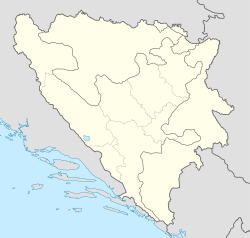world.wikisort.org - Bosnia_and_Herzegovina
Olovo (Serbian Cyrillic: Олово) is a town and municipality located in the Zenica-Doboj Canton of the Federation of Bosnia and Herzegovina, an entity of Bosnia and Herzegovina. It is situated about 50 kilometers northeast of the capital city of Sarajevo.
Olovo
Олово | |
|---|---|
Town and municipality | |
 View of Olovo | |
 Location of the Olovo Municipality within Bosnia and Herzegovina | |
 Olovo | |
| Coordinates: 44°7′39″N 18°34′48″E | |
| Country | |
| Entity | Federation of Bosnia and Herzegovina |
| Canton | |
| Government | |
| • Municipal mayor | Đemal Memagić (SDA) |
| Area | |
| • Town and municipality | 4,078 km2 (1,575 sq mi) |
| Population (2013 census) | |
| • Town and municipality | 10,175 |
| • Density | 26/km2 (70/sq mi) |
| • Urban | 2,465 |
| Time zone | UTC+1 (CET) |
| • Summer (DST) | UTC+2 (CEST) |
| Area code(s) | +387 32 |
| Website | www |
History
The town Olovo was first mentioned in the year 1382 under the name "Plumbum" (Latin for lead). The word olovo in Bosnian means lead, and the name was given to the town for its well-known lead ore deposits. Olovo stands on the Sarajevo–Tuzla highway M18, and is located 50 km northeast of Bosnia and Herzegovina's capital city of Sarajevo. Olovo is located in the Zenica-Doboj Canton. Recently, there have been attempts to make Olovo part of the Sarajevo Canton; however, the town remains within the Zenica-Doboj Canton . Since the Middle Ages, the town has been well known for its lead ore deposits, and Olovo was a mining town during medieval Bosnian state period, when the town and the region were part of the Pavlović's Land (Serbo-Croatian Latin: Zemlja Pavlovića) .
Features
Today, Olovo is best known for its coniferous forests, big blue skies, and clear swift waters coming from three main mountain rivers (Stupčanica, Krivaja, and Bioštica). Olovo hosts annual bullfights and festivals. It is a popular nightlife spot for youth from nearby villages. Olovo is also well known for its spa, which dates back to the period of Roman reign in the area.
Olovo is also a stopover for travelers to rest and change directions when traveling to cities such as Zenica and Zavidovići.
Demographics
According to the 2013 census, its population was 10,175 with 2,465 living in Olovo town.[1]
| Ethnic Composition | |||||||||||||
| Year | Serbs | % | Bosniaks | % | Croats | % | Yugoslavs | % | others | % | Total | ||
|---|---|---|---|---|---|---|---|---|---|---|---|---|---|
| 1961 | 3,635 | 32.07% | 5,903 | 52.09% | 314 | 2.77% | 1,402 | 12.37% | 11,333 | ||||
| 1971 | 3,601 | 23.68% | 10,546 | 69.36% | 930 | 6.11% | 46 | 0.30% | 80 | 0.55% | 15,203 | ||
| 1981 | 3,349 | 20.49% | 11,593 | 70.94% | 802 | 4.91% | 508 | 3.12% | 16,341 | ||||
| 1991 | 3,196 | 18.91% | 12,699 | 75.14% | 653 | 3.86% | 282 | 1.67% | 16,901 | ||||
| 2013 | 77 | 0.75% | 9,701 | 95.34% | 230 | 2.26% | 0.00 | 0.00% | 139 | 1.36% | 10,175 | ||
Inhabited places
There are many small villages in the vicinity of Olovo. These are: Boganovići, Čuništa, Solun, Hadre, Bukovdo, Milankovići, Kamensko, Jelaške, Careva Ćuprija, Lišći, Gurdići, Dugandžići, Čude, Petrovići, Klis, Kolakovići, Berisalići, Brda, Luke, Lavšići, Ponijerka, Grabovica, Dreželj, Paklenik, Majna, Radačići, Ajvatovići, Miljevići, Rudine, Ligatići and Bakići.
Notable people
- Jelena Blagojević, Serbian volleyball player
- Tima Džebo, Yugoslav and Bosnian basketball player
- Daniel Ozmo, Yugoslav Jewish painter and printmaker
- Edin Višća, Bosnian football player
References
- "Naseljena Mjesta 1991/2013" (in Bosnian). Statistical Office of Bosnia and Herzegovina. Retrieved February 1, 2022.
External links
| Wikimedia Commons has media related to Olovo. |
| Wikivoyage has a travel guide for Olovo. |
- Official website (in Bosnian)
На других языках
[de] Olovo
Olovo (kyrillisch Олово; deutsch veraltet: Blei) ist eine Kleinstadt im Zentrum von Bosnien und Herzegowina, nordöstlich von Sarajevo. Sie ist Hauptort und Verwaltungssitz der gleichnamigen Gemeinde (općina) im Kanton Zenica-Doboj mit 10.578 Einwohnern.- [en] Olovo
[ru] Олово (город)
Олово (босн. , серб. и хорв. Olovo / Олово) — город, центр одноимённой общины в Боснии и Герцеговине (Федерация БиГ, Зеницко-Добойский кантон). Располагается в 50 км к северо-востоку от Сараево на магистрали Сараево-Тузла. Название происходит, как ни странно, не от одноимённого химического элемента, а от сербского слова, переводимого как «свинец» — на территории общины ещё в Средние века были освоены залежи свинца. Через город протекает река Ступчаница, которая впадает в Биоштицу (та, в свою очередь, формирует реку Криваю, приток Босны).Другой контент может иметь иную лицензию. Перед использованием материалов сайта WikiSort.org внимательно изучите правила лицензирования конкретных элементов наполнения сайта.
WikiSort.org - проект по пересортировке и дополнению контента Википедии
